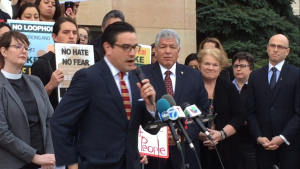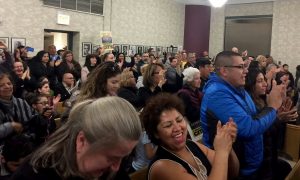Berwyn passes ‘welcoming city’ ordinance
By Jean Lotus Staff Reporter — April 18, 2017
Berwyn Ald. Cesar Santoy speaks in front of welcoming ordinance supporters at the Berwyn City Hall on 26th Street April 11. (Chronicle Media)
The Berwyn City Council unanimously passed a “Welcoming City Ordinance” April 11 that stops city officials and police from collaborating with the U.S. Immigration and Customs Enforcement (ICE) agency with regard to persons solely because of immigration status.
“I don’t’ want anyone to experience prejudice in the city that I’m a leader of,” said Mayor Robert Lovero. “The city of Berwyn has moved mountains to welcome people and invite them to move into our city. This is just another step on that adventure, on that path.”
Similar to the ordinance passed in Oak Park in February, the “no-loopholes” ordinance was crafted with the help of immigration attorney Mony Ruiz-Velasco, executive director of PASO, the Melrose Park-based West Suburban Action Project.
A similar ordinance in Melrose Park was rejected by Mayor Ronald Serpico and the village board the night before. The board refused to even take the matter under consideration.
In Berwyn, PASO joined forces with local organizations including the Interfaith Leadership Conference, the Illinois Coalition of Immigrant and Refugee Rights (ICIRR), and two newer organizations, Cicero-based Ixchel Committee and the Berwyn Immigration Working Group. Ald. Cesar Santoy and Ald. Rafael Avila also helped the city draft the ordinance.
“It is a step in the right direction,” said Ruiz-Velasco. “We are proud to see Berwyn join Oak Park in adopting a strong policy, which takes a firm stance against collaboration and deportations. We hope more suburban communities, including Melrose Park, will take heed and follow suit. There is no time to wait.”

The crowd cheers at a packed Berwyn City Council chambers after the welcoming city ordinance is passed unanimously April 11. (Photo courtesy of Cynthia Gutierrez)
The passage of the ordinance came just as U.S. Secretary of State Jeff Sessions doubled down on promises to “claw back” federal resources from “sanctuary cities.” An executive order from President Donald Trump and memos released from the Homeland Security Office say ICE aims to deport 3 million to 5 million persons with illegal immigration status this year. To do so, the DHS plan suggests deputizing local law enforcement agencies to help take immigrants into custody.
The Berwyn ordinance, modeled on a law passed in 2011 in Cook County, draws a “firm dividing line between police and ICE, disentangling the criminal and immigration system,” Ruiz-Velasco said. The new ordinance also forbids city employees from developing a registry of residents based on “race, gender, sexual orientation, religion, immigration status, or national or ethnic origin or to conduct civil immigration enforcement.”
“When my family and I came here over 50 years ago we were accepted and welcomed into the City of Berwyn, reluctantly at first,” said Mayor Robert Lovero. “When my father came home from the Korean war, he experienced prejudice because of his Hispanic surname,” Lovero said.
Not everyone in the packed council chambers agreed with the ordinance. A former alderman, Michael Phelan, visiting from Tennessee said he strongly opposed not cooperating with federal law enforcement officials. Others objecting to the law asserted that undocumented immigrants should take steps to become legal citizens.
“I agree,” Lovero said. “But until the federal government gets its act together [for immigration reform], we are doing this.”
Brenda Rodriguez of Ixchel Committee said a safe environment where immigrants lived without fear of deportation made the community safer.
“We know when cities adopt welcoming ordinances see lower crime rates and strong local economies,” Rodriguez said.
“We feel safe to call 911 with no repercussions, and I thank you for that,” said a man in the audience.
Berwyn Immigration Working Group have held a “Know Your Rights” event and helped Berwyn South District 100 craft and pass a “welcoming resolution” for the district in February. The group encouraged the school board to beef up the resolution and make the language more exact, spelling out exactly how school personnel would respond if ICE came on school property. The board passed a stronger resolution in March, said District 100 Board member Elizabeth Jimenez.
BIWG members also talked to business owners along Cermak Road to get support for the ordinance, said Berwyn resident Heather Horsley, a UIC education researcher.
“Really we are a group of concerned residents who got together to strategize about how we can support our neighbors and family around immigration policies at the federal level,” Horsley said.
“People are going to feel much safer in our community with this ordinance,” said newly elected City Treasurer Cynthia Gutierrez.
Although numbers aren’t exact, research published by ICIRR for the MacArthur Foundation estimates 54 percent of Illinois undocumented immigrant residents, about 125,000 people, live in suburban Cook County.
Illinois’ undocumented immigrants live mostly with family members and many households have mixed-status families that include U.S. citizen spouses and/or children, the study said. Berwyn and Cicero have a higher concentration of undocumented residents, as many as 1-in-4, although numbers are not exact, Horsley said.
Jimenez hopes the group can help bring professional development to teachers in Berwyn’s two school districts to improve the teachers’ cultural understanding of some students’ fears in a deportation era.
“It’s so important that we educate the community about what is going on,” Jimenez said.
Read the current issue of the Cook County Chronicle
Free subscription to the digital edition of the Cook County Chronicle
— Berwyn passes ‘welcoming city’ ordinance —



